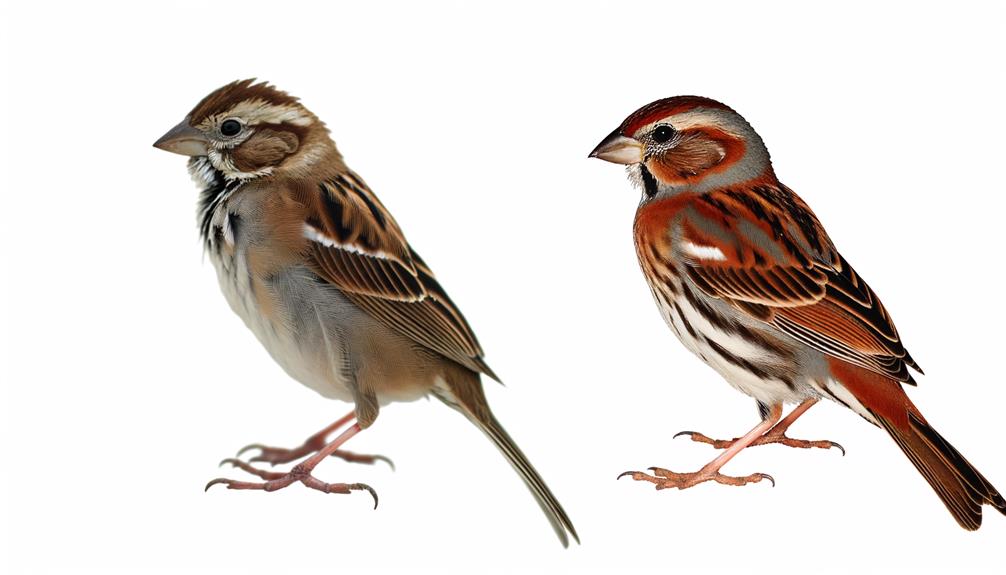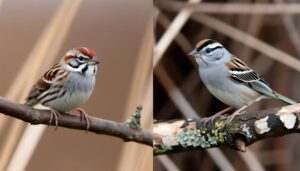10 Key Differences: Clay-Colored Sparrow vs. Fox Sparrow
The Clay-Colored Sparrow, typically 11-14 cm in size, is petite with muted, earthy colors and a unique gray cheek patch. It nests in shrubs, largely solitaire, and thrives in prairies.
On the other hand, the Fox Sparrow is more robust at 15-21 cm, sporting russet-colored plumage. It enjoys various habitats, demonstrating unique double-scratching feeding habits.
Their nests tend to blend into dense covers. Their respective songs vary greatly: while the former produces a buzzy tune, the latter whistles melodiously.
Going beyond these initial differences will surely lead to an even richer understanding of their behaviors, diets and adaptations.

Key Takeaways
- Clay-Colored Sparrows are smaller with muted coloration and unique facial patterns, while Fox Sparrows are more robust with russet-colored plumage.
- Fox Sparrows are adapted to various habitats and prefer dense cover, while Clay-Colored Sparrows thrive in shrublands and open areas with scattered trees.
- Fox Sparrows primarily feed on seeds, berries, and insects with a unique double-scratching habit, while the diet of Clay-Colored Sparrows isn't specified.
- Clay-Colored Sparrows nest in shrubs or low trees and may have multiple partners within a season, whereas Fox Sparrows nest on the ground and mate for life.
- Fox Sparrows whistle melodiously and join flocks in winter, while Clay-Colored Sparrows produce a buzzy song and are solitary outside the breeding season.
Overview of Sparrow Species
Numerous in nature, sparrows represent a diverse group of small, primarily brown and gray birds known for their adaptability and widespread distribution. There are over 140 species worldwide, with many varieties found in North America.
They're found in various habitats from city parks to desert landscapes. They're recognizable by their conical beaks and stout bodies, although their color and size can vary greatly among species. Sparrows primarily feed on seeds, but they're not picky eaters and they'll also consume insects and fruit.
These birds are social creatures, often found in flocks, and they're known for their lively, chirpy songs. Understanding the general characteristics of sparrows sets a foundation for a deeper exploration into the unique attributes of specific species, such as the Clay-Colored Sparrow and the Fox Sparrow.
Physical Attributes: Clay-Colored Sparrow
Taking a closer look at specific species, the Clay-Colored Sparrow is a small bird with distinctive physical features that set it apart from other sparrows. It's a petite creature, typically measuring between 11 to 14 centimeters in length and weighing around 11 to 16 grams.
Its name directly reflects its muted, earthy coloration. The bird's upperparts are generally buffy brown, mottled with darker streaks, whilst its underparts showcase a paler hue. Its facial pattern is notably unique, with a gray cheek patch contrasting sharply against a white stripe above the eye, and a chestnut crown. A white wing-bar is also present, further distinguishing it.
Its bill is comparatively small, and its tail is relatively short with pointed feathers. This sparrow's physical attributes are a sign of its adaptation to its prairie habitat.
Physical Attributes: Fox Sparrow
In contrast to the petite Clay-Colored Sparrow, the Fox Sparrow boasts a robust build, with its size typically ranging from 15 to 21 centimeters in length and its weight varying between 25 to 40 grams. They're known for their rich, russet-colored plumage that gives them their name, which is often thick and heavy, perfect for the harsh winters they commonly endure.
Fox Sparrows have a large, round head coupled with a stout, conical bill. Their tails are typically long and rounded. Their upperparts are reddish-brown with grayish underparts. They sport thick, dark streaks across their chest and flanks. Their wings are adorned with two white wing bars.
These physical attributes not only make the Fox Sparrow distinct but also well-adapted to its environment.
Diet and Feeding Habits
While their physical attributes equip Fox Sparrows to survive harsh winters, their diet and feeding habits further contribute to their adaptability. They primarily consume seeds, berries, and insects, foraging on the ground or low vegetation with their sturdy beaks. Their unique feeding habit, known as 'double-scratching,' wherein they kick backward with both feet to uncover food, sets them apart from other sparrows.
Clay-colored Sparrows, on the other hand, possess a diet primarily consisting of insects during breeding season, shifting to seeds and grains in other seasons. Their feeding habits are less distinctive than those of Fox Sparrows, as they forage in grassy areas, shrubs, and trees, often fluttering down to the ground to snatch up insect prey. Their dietary flexibility aids their survival in varied habitats.
Nesting and Breeding Differences
When it comes to nesting and breeding, Fox Sparrows and Clay-colored Sparrows show distinct behaviors and preferences.
Fox Sparrows typically construct their nests on the ground, camouflaged by vegetation, while Clay-colored Sparrows prefer to nest in shrubs or low trees.
The breeding season also varies, with Fox Sparrows breeding in late spring and Clay-colored Sparrows in early summer.
To summarize, here are the key differences:
- Fox Sparrows nest on the ground, Clay-colored Sparrows in shrubs or low trees
- Fox Sparrows breed in late spring, Clay-colored Sparrows in early summer
- Fox Sparrows use natural camouflage for nests, whereas Clay-colored Sparrows use height for protection
- Fox Sparrows have a wider range of nesting sites, Clay-colored Sparrows have more specific preferences
- Fox Sparrows mate for life, while Clay-colored Sparrows may have multiple partners within a season.
Clay-Colored Sparrow Habitat
Shifting our focus to habitats, the Clay-colored Sparrow primarily inhabits shrublands and open areas with scattered trees. This bird species has a predilection for regions with a mix of grass and low woody vegetation. It's particularly fond of early successional habitats, resulting from disturbances like fire or logging.
To better understand these preferences, here's a summarized overview:
| Habitat Type | Preference | Reason |
|---|---|---|
| Shrublands | High | Provides ample cover and feeding resources |
| Open Areas | Medium | Allows for easy flight and visibility |
| Forests | Low | Thick canopy restricts movement |
Understanding these habitat preferences can inform conservation efforts and predict how habitat changes might impact Clay-colored Sparrow populations. These birds aren't just survivors, they're adapters, thriving in landscapes transformed by both nature and humans.
Fox Sparrow Habitat
The Fox Sparrow exhibits a wide geographic distribution, spanning across North America, with notable concentrations in the Pacific Northwest, Alaska, and the Eastern Seaboard.
Its environmental preferences underscore its adaptability, as it thrives in varied habitats, from dense coniferous forests to scrublands and alpine meadows.
This interspersion across diverse regions and habitats exhibits not only the species' flexibility but also its unique ecological role within these communities.
Geographic Distribution
Across a vast expanse, Fox Sparrows inhabit diverse landscapes ranging from thickets and undergrowth in boreal forests and tundra edges in the north, to chaparral, thickets, and brushy areas in the west during winter months. Known for their adaptability, these sparrows have a broad geographic distribution that spans across North America.
The spatial distribution of Fox Sparrows can be summarised as follows:
- Mainly located in Alaska and Canada during breeding season.
- Migrate southwards to the United States during winter.
- Coastal regions of Pacific Northwest host year-round populations.
- Presence noted in mountainous regions of western US.
- East Coast sees occasional vagrants during migration periods.
This wide geographic spread, coupled with their distinct regional variations, makes Fox Sparrows an intriguing subject for ornithologists and bird enthusiasts.
Environmental Preferences
Fox Sparrows, with their adaptable nature, favor habitats that provide a dense undergrowth for nesting and foraging. They prefer environments that offer a blend of shrubby areas, young deciduous or mixed forest, and dense thickets. The Fox Sparrow's habitat preference varies across its extensive range, reflecting the species' adaptability.
In the western region, they're often found in chaparral, riparian thickets, and forest edges, while in the eastern part, they inhabit boreal and taiga forests. During winter, Fox Sparrows migrate to eastern and southern U.S., where they prefer brushy habitats and hedgerows.
They're also seen in urban and suburban areas, using bird feeders. This habitat versatility greatly contributes to the Fox Sparrow's survival and broad distribution.
Behavior and Vocalization Variances
Delving into their behavior and vocalization, one can spot significant differences between Clay Colored Sparrows and Fox Sparrows.
- Clay Colored Sparrows, known for their skittish nature, frequently flit between shrubs when disturbed, whereas Fox Sparrows are more ground-dwelling, often observed scratching at leaf litter in search of food.
- Concerning vocalization, Clay Colored Sparrows produce a distinct, buzzy song, while Fox Sparrows have a rich, melodious whistle.
- Fox Sparrows exhibit a variety of regional song dialects, unlike the more uniform vocalizations of Clay Colored Sparrows.
- Clay Colored Sparrows are largely solitary outside of breeding season, while Fox Sparrows often join mixed-species flocks in winter.
- Fox Sparrows have an elaborate courtship display, marked by wing-flapping and singing, unlike the more subdued Clay Colored Sparrows.
Conservation Status and Threats
Examining the conservation status of both the Clay Colored Sparrow and the Fox Sparrow is crucial. It's important to observe their positioning on the Endangered Species List.
These species' sustainability is invariably shaped by potential environmental risks, which may jeopardize their existence.
As such, a thorough understanding of these threats will aid in formulating effective conservation strategies.
Status on Endangered List
Listed as species of least concern, both the Clay Colored Sparrow and the Fox Sparrow aren't currently facing any immediate threats of extinction, according to the International Union for Conservation of Nature (IUCN).
Each species' status is ascribed based on various factors:
- Population Trend: The populations of both species remain steady, showing no signs of significant decline.
- Habitat Availability: Both Clay Colored and Fox Sparrows have a broad geographical range, with sufficient habitat availability.
- Threat Level: Currently, no immediate, high-level threats are impacting either species.
- Reproduction Rates: Both species display healthy reproduction rates, aiding in maintaining stable population numbers.
- Human Impact: The impact of human activities on these species is currently minimal, allowing them to thrive in their natural habitats.
Thus, both species are in a secure conservation status, not warranting any immediate concern.
Potential Environmental Risks
While both the Clay Colored Sparrow and the Fox Sparrow are currently in a secure conservation status, it's important to understand potential environmental risks that could pose threats to their survival in the future. Habitat loss is a major concern, as these sparrows rely on specific environmental conditions for survival.
Urban development, agriculture, and logging can drastically alter their habitats. Climate change also poses a significant threat, potentially causing shifts in their food sources and migration patterns. Finally, invasive species may compete with sparrows for resources or introduce new predators.
Though these species aren't currently under threat, proactive steps to mitigate these risks can help safeguard the continued survival of these unique birds.
Conclusion
To sum up, the clay-colored sparrow and the fox sparrow each have unique attributes, diets, and habitats. An example of this is the fox sparrow's preference for dense forest undergrowth, contrasting with the clay-colored sparrow's tendency to nest in open shrubland.
Further observation and study of these species can enhance our understanding, leading to improved conservation efforts. The beauty of nature lies in such diversity, which deserves our attention and protection.





